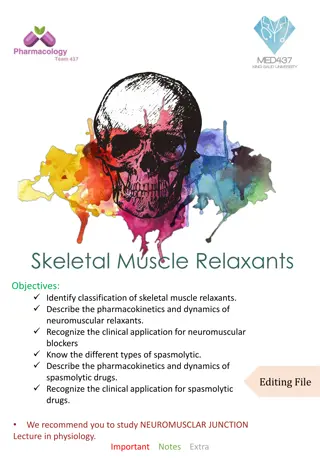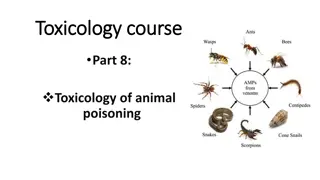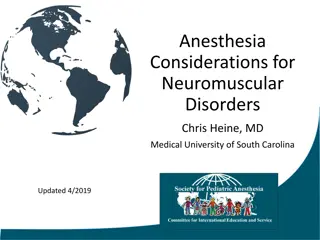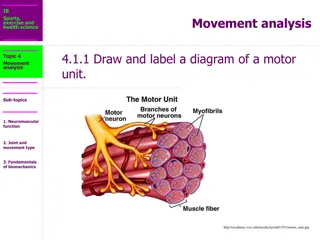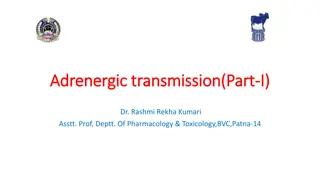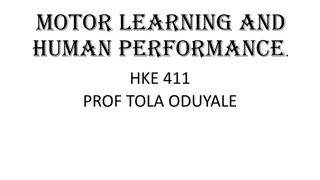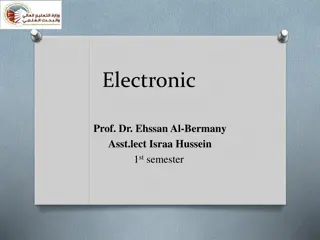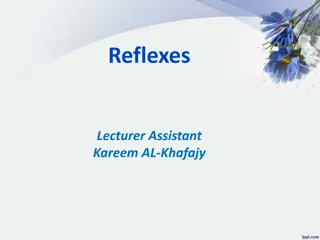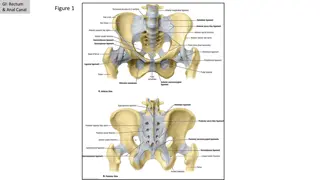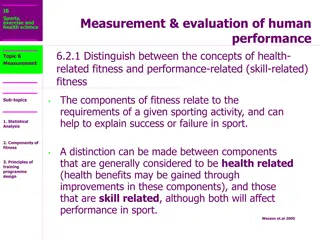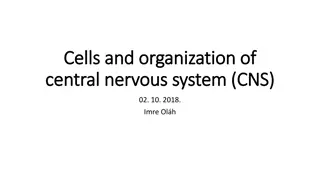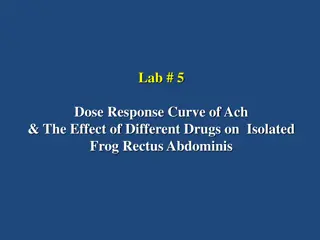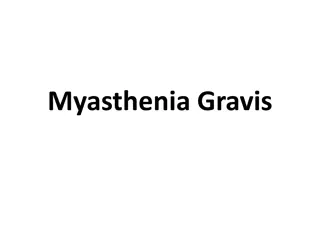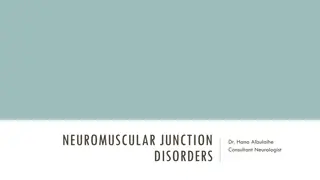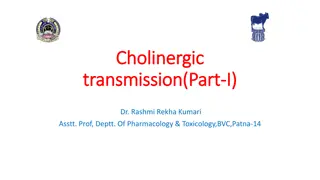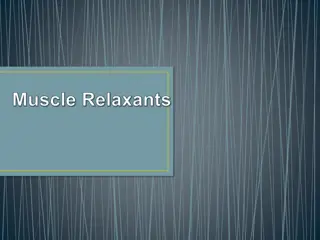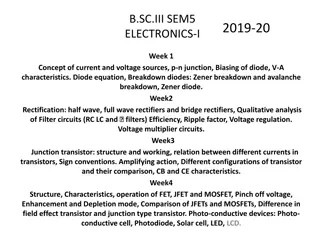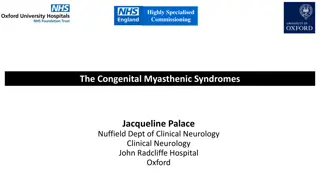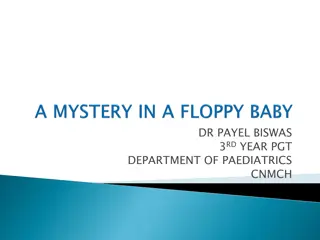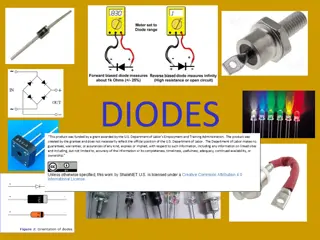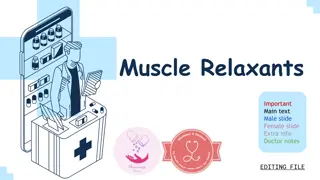Neurologic Disorder
Structural divisions of the central and peripheral nervous systems, learn about neuron anatomy, the neuromuscular junction, and the role of neurotransmitters. Includes information on Acetylcholine, Norepinephrine, Dopamine, and Serotonin.
0 views • 24 slides
Skeletal Muscle Relaxants and Neuromuscular Blockade
Skeletal muscle relaxants are used to induce muscle relaxation during surgeries. Neuromuscular blocking agents act at the neuromuscular junction. These drugs can either peripherally reduce muscle tone or centrally cause muscle paralysis. Different types of muscle relaxants are classified based on th
6 views • 23 slides
Understanding Strength-Duration (SD) Curve: A Neuromuscular Diagnostic Test
Strength-Duration (SD) curve is a diagnostic test assessing neuromuscular integrity by measuring the relationship between stimulus strength and duration. It helps in electro-diagnosis of peripheral nervous system disorders and evaluates nerve degeneration and regeneration. The curve is obtained by p
2 views • 17 slides
Skeletal Muscle Relaxants: Classification, Pharmacokinetics, and Clinical Applications
Skeletal muscle relaxants encompass different types, including neuromuscular blockers, spasmolytic drugs, and peripherally-acting agents. They are classified based on mechanisms of action and play crucial roles in inducing skeletal muscle relaxation for various clinical applications. Understanding t
3 views • 12 slides
Understanding Animal Venom and Snake Classification in Toxicology
Animal venom, particularly snake venom, contains various toxins that can have detrimental effects on the body. Different types of snake venom target specific systems, such as neurotoxic venom affecting neuromuscular junctions and hemotoxic venom impacting the cardiovascular system. Understanding the
4 views • 27 slides
Understanding Flexibility: Types, Methods, and Benefits
Flexibility is the ability of joints to move within their maximum range, crucial for overall health and sports performance. It can be passive or active, and there are various methods to enhance it such as ballistic, static stretching, dynamic stretching, and proprioceptive neuromuscular facilitation
0 views • 8 slides
Understanding Solar PV Components: Cells, Modules, and Arrays
Solar PV components such as cells, modules, and arrays play a crucial role in converting sunlight into electricity. This unit covers basic terms related to solar PV components, including solar cells, P/N junctions, cell output, various cell constructions, and cell wiring configurations. Explore the
1 views • 15 slides
Anesthesia Considerations for Neuromuscular Disorders: Overview and Management
This informative document discusses the classification of neuromuscular disorders, focusing on muscle and muscle membrane disorders such as Muscular Dystrophy. It delves into the characteristics, pathology, and clinical presentations of different types of muscular dystrophies, including Duchenne and
0 views • 42 slides
Understanding Motor Units and Neurotransmitters in Muscle Contraction
Motor units consist of a motor neuron and the muscle fibers it innervates. Neurotransmitters like acetylcholine play a vital role in stimulating muscle contraction by transmitting signals at the neuromuscular junction. This communication between neurons and muscles is essential for proper movement a
0 views • 30 slides
Understanding Adrenergic Transmission and Catecholamine Synthesis
Adrenergic transmission involves the release of neurotransmitters such as norepinephrine, dopamine, and epinephrine at synapses or neuroeffector junctions. These neurotransmitters, known as catecholamines, play crucial roles in transmitting impulses in the sympathetic nervous system and central nerv
0 views • 14 slides
Understanding the Biological Basis of Human Motion and Motor Learning
In the biological basis of human motion, a series of electro-chemical-physical reactions occur at the neuromuscular junction, enabling nerve stimulation for muscle contraction. Nerve impulses for movement originate in the central nervous system or muscles, with acetylcholine transmitting impulses be
0 views • 13 slides
Understanding Strength-Duration Curve in Neuromuscular Stimulation
The strength-duration curve depicts the relationship between electrical stimulus intensity and time required for minimal muscle contraction. It helps assess nerve damage in lower motor neuron lesions. Various types of curves exist based on innervation status, such as normal innervation, complete den
0 views • 15 slides
Understanding Diodes: Basics and Applications
Diodes are essential semiconductor devices consisting of p-n junctions that allow current flow in one direction while offering high resistance in the other. This summary covers topics such as diode structure, forward biasing, and reverse biasing, providing a fundamental understanding of diodes.
0 views • 19 slides
Understanding Avalanche Photodiodes: Principles and Applications
Explore the world of Avalanche Photodiodes (APDs) through a comprehensive discussion covering solid-state physics, band theory, PN junctions, I-V characteristics of diodes, breakdown mechanisms, and practical design considerations. Learn about linear mode versus Geiger mode operation, performance me
0 views • 31 slides
Understanding Ergonomics for the Elderly: Adapting to Age-Related Changes
Our bodies and minds undergo changes as we age, necessitating adjustments in our environment to accommodate limitations. The design of everyday products often overlooks the needs of older individuals, leading to difficulties in tasks such as handling objects and sensory impairments. This article dis
0 views • 19 slides
Understanding Infant Reflexes and Their Importance in Development
Explore the world of infant reflexes with a focus on assessing, defining, and understanding their significance in children's neuromuscular health. Learn about feeding reflexes, protection reflexes, and more, as well as how to observe and interpret a child's responses to different types of reflexes.
0 views • 17 slides
Anatomy of GI Rectum and Anal Canal: A Detailed Visual Guide
This visual guide showcases detailed images of the gastrointestinal (GI) rectum and anal canal anatomy, including structures such as the perineum, pelvic diaphragm, external and internal anal sphincters, and various junctions within the rectum. Each image provides a clear depiction of the anatomical
0 views • 6 slides
Understanding Semiconductors: Intrinsic and Extrinsic Types
Semiconductors play a crucial role in electronic devices, with materials falling into three categories based on electric conductivity: Conductors, Insulators, and Semiconductors. Intrinsic semiconductors are chemically pure, while extrinsic semiconductors have impurities added to enhance their condu
0 views • 39 slides
Understanding Health-Related and Performance-Related Fitness Components in Sports Science
Distinguishing between health-related and performance-related fitness components is crucial in understanding how fitness impacts success in sports. Health-related factors are physiologically based, influencing an individual's ability to meet physical demands, while skill-related factors are based on
0 views • 75 slides
Overview of the Central Nervous System and Neurotransmitters
The human central nervous system (CNS) is composed of neurons that transmit information through electrical impulses and neurotransmitters at synaptic junctions. Synapses play a crucial role in interneuronal communication, with various types and features impacting information transmission. Neurotrans
0 views • 13 slides
Understanding Neuromuscular Transmission and Drug Effects on Frog Rectus Abdominis
The content explores the neuromuscular transmission process in frog rectus abdominis, focusing on the release of Ach and its effects on Nm receptors. It also discusses the impact of different drugs on skeletal muscles, both centrally and peripherally acting, including those that act presynaptically
0 views • 12 slides
Understanding Myasthenia Gravis: Symptoms, Diagnosis, and Management
Myasthenia Gravis (MG) is a neuromuscular disorder characterized by muscle weakness and fatigability due to a decrease in acetylcholine receptors at neuromuscular junctions. It primarily affects individuals in two age peaks, with different symptoms and gender predominance. The cardinal feature is we
0 views • 25 slides
Understanding Neuromuscular Junction Disorders with Dr. Hana Albulaihe
An in-depth exploration of neuromuscular junction (NMJ) anatomy, physiology, and associated disorders by Dr. Hana Albulaihe, a renowned Consultant Neurologist. The NMJ comprises the axon terminal of a motor neuron and the motor end plate of a muscle fiber. Disorders discussed include Myasthenia grav
0 views • 75 slides
Understanding Cholinergic Transmission in Neurohumoral Signaling
Cholinergic transmission plays a crucial role in neurohumoral signaling, involving the release of acetylcholine at synapses and neuroeffector junctions. Dr. Rashmi Rekha Kumari explains the synthesis, storage, release, and catabolism of acetylcholine, highlighting the role of choline acetyl transfer
0 views • 11 slides
Understanding Muscle Relaxants: Mechanisms and Applications
Muscle relaxants play a crucial role in managing conditions like spasticity and painful spasms. Centrally active agents modulate motor impulses in the spinal cord and CNS, while peripherally active agents target neuromuscular junctions. Baclofen, benzodiazepines, and other specific drugs serve vario
0 views • 13 slides
Advanced Topics in B.Sc III Semester 5: Electronics, Condensed Matter Physics, Nuclear and Radiation Physics
Explore advanced concepts in Electronics-I like current and voltage sources, p-n junctions, diode biasing, rectification techniques, and transistor characteristics. Delve into Crystal Structure and Crystal Diffraction in Condensed Matter Physics, and learn about nuclear forces, radioactivity, and nu
0 views • 24 slides
Specialised Commissioning for Congenital Myasthenic Syndromes - Overview by Professor Jacqueline Palace
Delve into the highly specialised commissioning of Congenital Myasthenic Syndromes by Professor Jacqueline Palace from the Nuffield Department of Clinical Neurology at John Radcliffe Hospital, Oxford. Explore key messages, learning objectives, and disclosures related to diagnosing, differentiating,
0 views • 4 slides
Innovative Road Junction Design to Combat City Congestion
City congestion in Castlebay is causing frustration among young people due to traffic delays, affecting their social activities and school routine. Students investigated the issue and proposed changes to traffic light junctions. The Castlebay council consulted with Transport for Castlebay (TfC) to e
0 views • 10 slides
Highways England Capital Improvement Schemes 2020/21 on M11 - Meeting Overview
A meeting overview for the Highways England Capital Improvement Schemes 2020/21 on the M11 motorway between Junctions 9 and 12. The meeting discusses the purpose, scope, and necessity of the planned works including bridge joint replacements, road marking enhancements, and carriageway improvements. S
0 views • 15 slides
Understanding Skeletal Muscle Relaxants and Muscle Contraction Mechanisms
Skeletal muscle relaxants play a crucial role in relaxing muscles without affecting consciousness significantly. They are classified into neuromuscular blockers and spasmolytics, each targeting different mechanisms in the body. Muscle contraction occurs through the release of acetylcholine and the s
0 views • 27 slides
Differential Diagnosis of Infant with Sudden Onset Weakness and Neurological Symptoms
A 2-month-old infant presented with sudden onset weakness in all four limbs following an upper respiratory tract infection. Clinical findings include froglike posture, diminished tone in all limbs, absent reflexes, and cranial nerve involvement. Possibilities include brainstem encephalitis, myelitis
0 views • 29 slides
Understanding Diodes: Construction, Characteristics, and Applications
Explore the world of diodes through detailed explanations of construction methods, electrical characteristics, and V-I characteristic curves. Learn about forward and reverse biasing, diode applications, and diodes used as rectifiers. Delve into alloyed and diffused junctions, PN junction basics, bar
0 views • 26 slides
Overview of Skeletal Muscle Relaxants and Neuromuscular Blockers
Skeletal muscle relaxants and neuromuscular blockers are important drugs used to induce muscle relaxation. They are classified based on their site of action and mechanism of action. Understanding their classification, pharmacokinetics, and clinical applications is crucial for medical professionals.
0 views • 25 slides
Medications in Acute Care: Impact on Physical Therapy
Side effects of medications in the acute setting can manifest as impairments in various body systems, including integumentary, musculoskeletal, cardiovascular/pulmonary, and neuromuscular systems. Factors influencing adverse drug events include pharmacokinetics, drug interactions, and patient-specif
0 views • 24 slides



